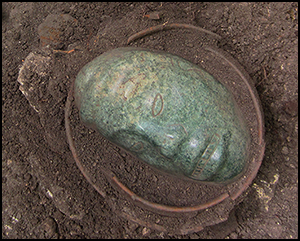Article contents
The weight of ritual: Classic Maya jade head pendants in the round
Published online by Cambridge University Press: 27 June 2018
Abstract

A newly discovered jade head pendant from the Guatemalan site of Ucanal illuminates a rarely considered element of Classic Maya royal ceremonies: weight. The largest and probably the heaviest of its kind, this pendant is a rare example of Classic Maya belt ornaments. Finely carved jade ornaments symbolised the prestige and wealth of elite officials, but were also metaphors for the weighty burdens of office. This paper considers the phenomenological role of jade jewellery, which would have encumbered Maya royalty greatly during public ceremonies. While such a perspective underscores the ritual work of elites, an analytical focus on weight also highlights the anonymous people who carried burdens.
- Type
- Research
- Information
- Copyright
- Copyright © Antiquity Publications Ltd, 2018
References
- 8
- Cited by


